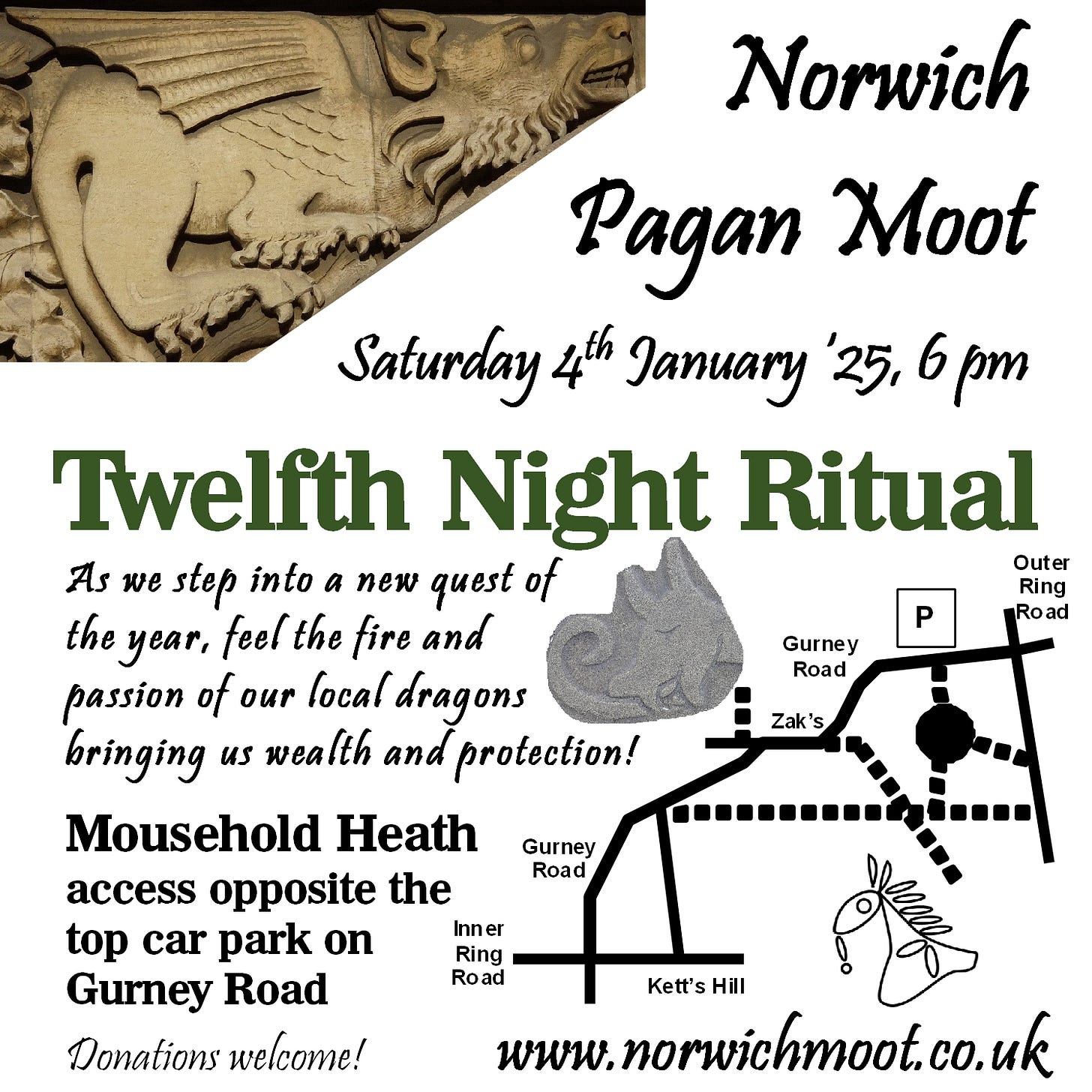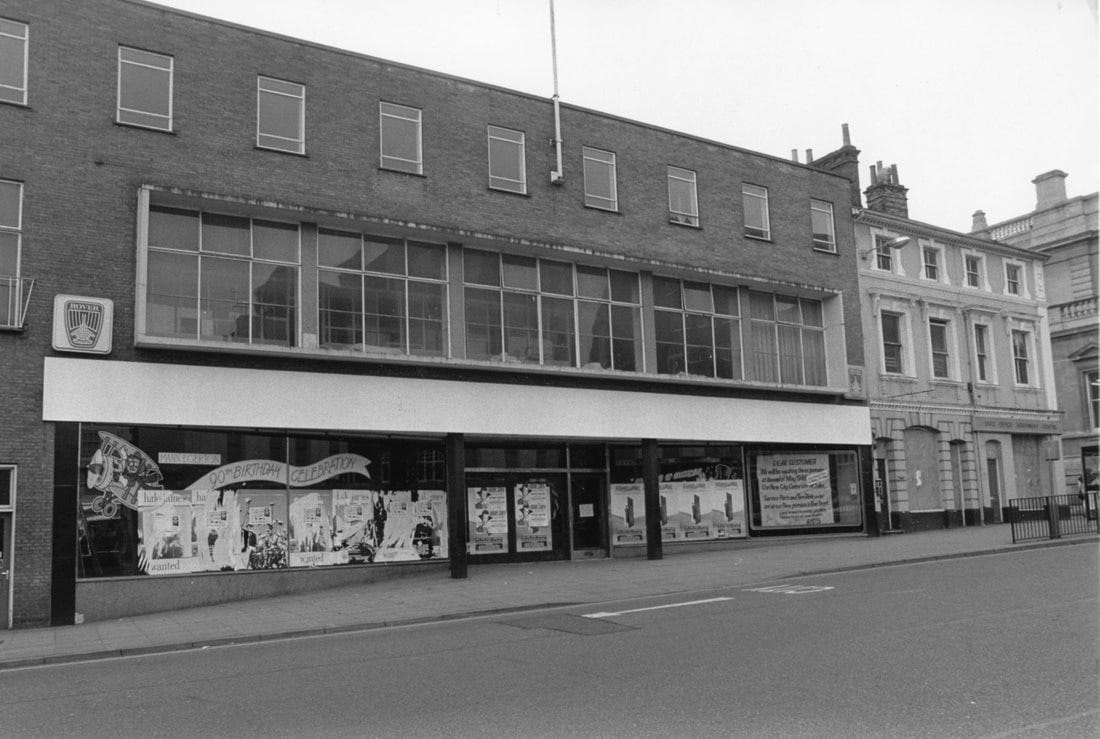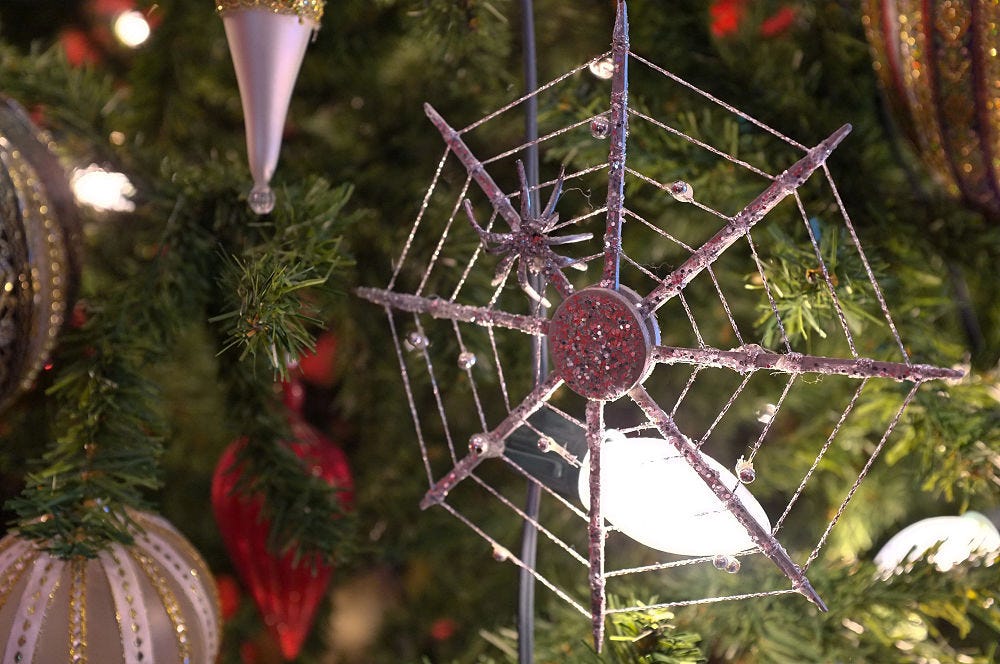Norfolk Folklore Society - December 2024
A note from Siofra
Hello folklore friends,
Another short note from me I’m afraid. I’m sure I’ve done a lot since our last newsletter. But as you’ve probably noticed, this month’s edition is a day late, and I’m feeling a little frantic with festive preparations, which means my mind has gone blank and I can’t think of anything to write. But Stacia’s little note sums things up nicely. So, to make sure this newsletter isn’t even more late, I’ll pass you to Stacia.
I’m looking forward to see some of you at Wednesday’s talk at Carrow House. Or at Norwich Pagan Moot’s Twelfth Night Ritual at Mousehold Heath in the new year. Or maybe event the Whittlesea Straw Bear Festival…
I hope you all have a lovely Yule.
Love Siofra
💚
A note from Stacia
You never know where life might take you – one minute you’re talking to Snapdragon, the next you’re appearing on a bottle of room mist that smells like a haunted stone and then you’re having meetings about your very own festival. Life in the Norfolk Folklore Society is never dull!
We’ve had an exciting month with collabs and folklore heroes and planning afoot for the first Norfolk Folklore Society Festival next year. I am now knee-deep in tinsel at my day (and night) job and will be helping my team deliver Christmas to thousands of people over the next few weeks. I’m looking forward to a night off for our last talk of 2024 and some chilling ghost stories in a slightly less chilly room than the Orangery at Carrow House.
I don’t know what 2025 has in store and I am nervous, but as ever, I’ll keep putting one foot in front of the other, and repeating. In every beginning, we hold the memory of what’s come before, and such knowledge can both help and hinder us. And of course, not every beginning is welcome and that’s another immense hurdle to jump: it’s a good job I’ve got a lot of NFS plans to keep me occupied in the darker months!
Love, Stacia
The Haunting of Mann Egerton’s: The Ghostly Nun of Prince of Wales Road
There was an unspoken chill that fell over Mann Egerton’s boiler room, settling like a silent warning in the shadows.
When the temperature dropped and the lights seemed to dim, Mr. A.W.P. Pullinger knew what was about to happen; he had felt this creeping cold too many times to dismiss it as coincidence.
“I feel it before she appears,” he said, when interviewed at the time. And just seconds later, the ghostly nun would make her entrance, bound to the darkness in the heart of Norwich.
It was in the 1940s and again in the 1960s that the nun began her spectral visits. Mann Egerton’s headquarters on Prince of Wales Road, with its bustling industry and the hum of machines, was an unlikely setting for a haunting.
But there she was—visible in the daylight, her black habit and white headdress casting no shadow as she glided over the cold concrete floors.
Mr. Pullinger, an engineer, was no stranger to the practicalities of his trade, yet he could hardly ignore the apparition that crossed his path three times in one year.
“The nun looks as solid as you or I,” Pullinger told a reporter from a local newspaper in December 1960, his words laced with reverence and a touch of dread.
“She walks as if she’s making rounds in a hospital ward, her footsteps barely stirring the silence.”
She would emerge from behind the boilers, crossing the room with a purposeful stride before slipping, soundless, through the fireproof door—a door that stayed locked. Her form was uncanny in its realism: a dark robe, sturdy black shoes, and a faintly rustling hem, all impossibly intact.
Strangely, the nun chose not the cloak of night but rather the blunt clarity of daylight. Pullinger explained, “She always appears when the lights are on. There’s no mistaking her presence—solid, unsettling, and far too real.” He felt no fear, just an unshakable cold that cut deeper than the winter air.
It was as if the nun’s essence drew warmth from the room, her presence woven into the bones of the building itself.
The origins of this apparition were a mystery, but there were whispers. Mann Egerton’s stood on ground with a layered past; the building’s foundations lay near the site of Greyfriars, a 13th-century Franciscan priory, and Cooke’s Hospital, an almshouse that once offered sanctuary to Norwich’s impoverished women.
Had this solemn nun walked these grounds centuries ago, perhaps tending the sick or praying for lost souls? Or was she a spectral echo of Carrow Abbey’s ancient sisters, seeking her way back through time?
The haunting was not confined to Norwich alone. Odd happenings were also reported at Mann Egerton’s Bury St. Edmunds branch across the Suffolk border. There, cleaning staff refused to work after dark, disturbed by the uncanny feeling of being watched and the clocks ticking backward on their own accord. Objects moved without warning, and eerie noises disrupted the night. Here, the culprit was no ghostly nun but something darker—a restless poltergeist.
As for Pullinger, he remained steadfast in his recounting of the nun’s spectral visitations. “I first saw her before the war, in the basement,” he said. The sightings had tapered off by the time the 1960s rolled around, as if she had finally been laid to rest.
But for those who still wander near Prince of Wales Road, a faint chill in the air may yet linger, a trace of the nun who walked solid and silent, bound to a past that refuses to let go.
The Enchantment of December's Cold Moon
As the final full moon of the year ascends over Norfolk’s frost-kissed fields, it carries with it an aura of magic and mystery. December's Cold Moon, named for the biting chill that grips the land during the darkest nights, is steeped in folklore that speaks to the heart of winter’s enchantments.
Known as the Cold Moon by Native American tribes and the Long Night Moon in Europe, this luminous orb shines brightest against the backdrop of the year's longest nights.
It is said that its light calls forth spirits who linger between this world and the next, illuminating their path as they walk the landscape. Some believe it is a time when Black Shuck is most often seen prowling under the moon’s silver glow, his eerie howl harmonising with the whispers of the icy wind.
For centuries, the Cold Moon has been seen as a time of reflection and renewal.
In medieval Norfolk, locals would perform simple rituals on the night of the full moon, leaving offerings of bread or mead at crossroads to ward off bad luck for the coming year. It was also thought that gazing at the Cold Moon's reflection in still water could grant glimpses of hidden truths or the future.
Even today, the Cold Moon's light feels otherworldly, casting long shadows on the quiet marshes and ancient hedgerows. Whether you believe in its folklore or simply admire its beauty, there is no denying the sense of wonder it inspires. As the Cold Moon rises, take a moment to step outside and feel its chill upon your skin—it’s a reminder that even in the depths of winter, magic lingers in the air. The Cold Moon, the last full moon of 2024, will occur on Sunday, December 15 at 4:02am.
Yule Moon Biscuit recipe
Ingredients:
Biscuit:
225g unsalted butter
250g caster sugar
2 tsp grated lemon zest
¼ tsp salt
170g plain flour
150g finely ground blanched almonds
1 tsp vanilla extract
Icing:
250g icing sugar, sifted
1 tsp vanilla extract
2½ tbsp water
Method:
Prepare the Dough:
Cream together the butter and caster sugar until light and fluffy. Add the grated lemon zest, salt, flour, ground almonds, and vanilla extract. Mix thoroughly until a smooth dough forms. Transfer the dough to a bowl, cover, and chill for at least 1 hour, or overnight for best results.
Shape the biscuits:
Preheat your oven to 190°C (fan 170°C) or Gas Mark 5. Roll the dough out to a thickness of about 3mm (⅛ inch). Use a crescent-shaped cookie cutter to cut the dough into moon shapes. Place them on an ungreased baking tray, spacing them about 1cm (½ inch) apart.
Bake in the preheated oven for 8–10 minutes, or until the edges of the biscuits are just beginning to turn golden.
Make the Icing:
While the biscuits are baking, combine the icing sugar, vanilla extract, and water to create a smooth glaze. Add a few more drops of water if the glaze is too thick. Spread the glaze over the biscuits while they are still warm but not too hot, to prevent the icing from melting. Allow them to cool completely so the glaze can set.
The story of the Christmas Spider
I have a LOT of vintage Christmas decorations, from beautiful glass globes that date from the 1920s to gaudy plastic nativity scenes and the trinkets that were passed down from my Nanna to my Mum and then to me. As I bring them up from the cellar for their annual airing, it’s impossible not to fall in love with them every single time I unpack them from their tissue paper.
Of course, there have been many along the journey that I have loved and lost, inevitably time, clumsiness or my Mum’s cats claiming another delicate glass treasure. Every year, my favourites were the mercury glass figures: Father Christmas with a pipe cleaner staff and a bauble for a head, a paper snowman wearing a cardboard pork pie hat, a Christmas turkey, creepy clowns, and the Christmas Spider. Sadly, the spider went to the great glass graveyard in the sky when one of my Mum’s cats took a shine to it, but I remember the story that accompanied it on a piece of paper in its box. This year I have a new Christmas Spider and so here is the story, so you can look out for your own.
“Once upon a time, a poor hard-working widow lived in a small hut with her children. One summer, a pine cone fell on the earth floor of the hut and began to grow. The widow’s children cared for the tree in the hope that by Christmas it would have grown enough to decorate. Christmas Eve arrived and the tree was ready. Unfortunately, the poor widow could not afford any decorations for the tree: the children were sad, but went to bed and fell asleep. Early the next morning, they woke up and saw the tree covered with cobwebs. When they opened the windows, the sunlight streamed through and touched the webs, turning them into a spectacle of gold and silver. The widow and her children were very happy.”
Make your house smell like a haunted stone
If that’s not a compelling strapline for our collaboration with the wonderful Norfolk Apothecary crew and Shuck illustrator Matt Willis, I don’t know what is…The first batch of the Great Stone of Lyng room and fabric mist sold out in less than 24 hours, but there’s still a chance to pre-order a bottle HERE.
The limited edition collab is inspired by the mysterious and ancient stone and is made with a soft, comforting and woody blend of essential oils including pine, bay, sandalwood, sweet orange and cinnamon. It’s vegan, cruelty-free and comes in a reusable glass bottle finished with hand-dried moss and a beautiful aventurine crystal for strength, balance and abundance. It’s £12 for 100ml, which will be the best £12 YOU EVER SPEND.
Look out for future collabs!
NFS Alphabet: U is for…UFO (sorry, Siofra)
Red, green and white lights off the coast of Cromer at New Year can generally be explained by the town’s annual firework display: but in 1978, they were due to a close encounter of a very different kind.
On Sunday December 31, a UFO was spotted flying around two miles off the coast at Cromer – it was also seen at the same time from Skegness.
Witnesses assumed the craft they had spotted at sea was an aircraft, but this was quickly discounted when the air traffic control centre at West Drayton in Middlesex confirmed no planes, either civil or military, had been in the area at that time.
Both sightings – which lasted for less than a minute – were reported just after 7pm: coastguards at Cromer reported seeing an object moving from north to south while the report from Skegness gave its direction as west to east off the Lincolnshire coast.
The local newspaper of January 2 1979 dedicated its front page to the sighting.
“First impressions were that it was an aircraft about to crash into the sea,” said the report, “two coastguards at Cromer saw the UFO through high-powered observation equipment.
“Mr H.V. Brown, an auxiliary coastguard and Mr Colin Handforth, a full-time coastguard, were on duty at Cromer when they saw what looked like a spaceship.
“Mr Brown explained, ‘At first it looked like a big light and then an airship. It came just opposite us about two or three miles out, over the sea. It looked 200 yards long with bands of whitish light coming off in all directions. It looked like a spaceship.’”
A spokesman at HM Coastguard rescue headquarters at Gorleston, to whom the sightings were reported, said: “It had a line of red and green lights down the side and something like a bright glow surrounded it.
“It was between one and three miles from the coast and its height was estimated at 800 to 1000 feet, although that can only be an assumption.”
He added that it was so clear and so close that the coastguard thought it was a Boeing 707 with all its lights on.
Other reports of similar-sounding lights flooded in from around the country – from Wales, Tyne, Teeside and Humber and elsewhere along the east coast.
Explanations ranged from a plane making its way to Amsterdam to a re-entry of some part of an object from a space probe – but the UFO seen from Cromer was moving horizontally along the coast, not coming down vertically.
The Gorleston spokesman said: “We can only put it down as a report of something unidentified, whether it was a space vehicle re-entering or what it was. For us there is no punch line. We are left in the dark.”
One popular theory as to what UFOs are is that they are craft piloted by time-travelling humans returning from the future to study us.
A recent book, Identified Flying Objects: A Multidisciplinary Scientific Approach to the UFO Phenomenon (Michael Masters, Masters Creative LLC 2019) puts forward the idea that humans of the distant future could have developed the knowledge and machinery necessary to return to the past.
He writes: "Undoubtedly in the future, there are those that will pay a lot of money to have the opportunity to go back and observe their favourite period in history.
“Some of the most popular tourist sites are the pyramids of Giza and Machu Picchu in Peru … old and prehistoric sites."
It seems entirely reasonable that one place future humans would definitely want to visit would be Cromer…if only for the chips.












